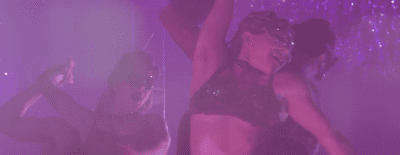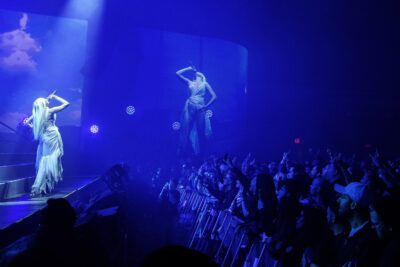You Are Here Fest: A Holiday Weekend Spent Inside a Giant Maze in the Middle of Industrial Queens
You can’t really know how a giant see-through maze might change things until you find yourself there, inside of one. An average concert falls into a soft tidal pull. You inch toward the stage until you meet resistance, fill pockets of sudden absence as someone in front of you exits. You suck in to let drink-holders go sloshing past, or take a down moment to wade back to the bar or the bathroom yourself. Venturing inside a big ol’ labyrinth to watch music, peering at it through wire and wood, knowing where I wanted to go but confused as to how to actually get there, the usual dependence on lazy action became clear. Even passive enjoyment would require much more deliberation.
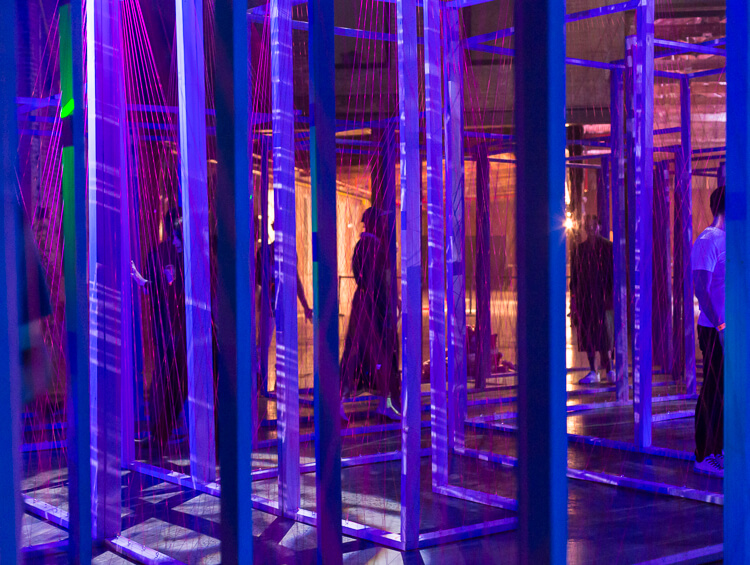
Over the long holiday weekend, the see-through maze in question stood on a relatively small portion of floor in the Knockdown Center, a truly grand door factory turned benevolent arts space in the industrial blight where Brooklyn becomes Queens. It took the local art collective Trouble six full days to erect the structure, to paint it light pastel purple, string it with nylon wire and add some stray piles of faux skulls and disembodied faces just so. Trouble’s first maze in 2007 sprang from an in-joke between Zs saxophonist Sam Hillmer and his collaborator (and wife) Laura Paris. “Her idea was that there was a club somewhere. You entered this club and it’s sort of an elaborate series of hallways that just deposits back you on the outside.” But if there’s nothing inside, why would people show up in the first place? They settled on a performance aspect quickly and tweaked the concept from there into their semi-annual “You Are Here” festival. Previous builds happened inside snug DIY spots like Death by Audio or Secret Project Robot. This year’s maze was “100% bigger” than 2012’s. Hillmer says he feels no compulsion to be rigid with the event’s regularity. This time it came to life as a commissioned event by the venue, with first discussions starting almost a year ago. “If it wasn’t here,” he said, “it wouldn’t necessarily have been at all.”
They booked events Thursday through Sunday, colluding with local promoters and art scenes to give each day and night a distinct character. The festival’s most statured experimental music names gathered on Friday. Legendary avant guitarist Loren Connors, a collaborator and inspiration to figures like Jandek, Thurston Moore, and Jim O’Rourke, played first. In a sharp blazer and frayed shorts Connors looked frail but dapper, like a shipwrecked aristocrat. He struck and strummed his guitar, finding a place where foundational blues chords might linger deepening into drones that were either unsettling or oddly pretty. Arto Lindsay, a pivotal figure in New York No Wave, provided more structure. He tamed harsh, ear-baffling static into tight riffs and sometimes smoothed that abrasion with bits of Portuguese balladry. For their set, Hillmer’s Zs entered dramatically from all sides of the maze, squeezing past viewers mid-wail. Despite having built the damn thing, he admitted later that his confidence in finding its center while playing the sax was shaky at best. “The bigger it is, the easier it is to make something that’s actually disorienting.”
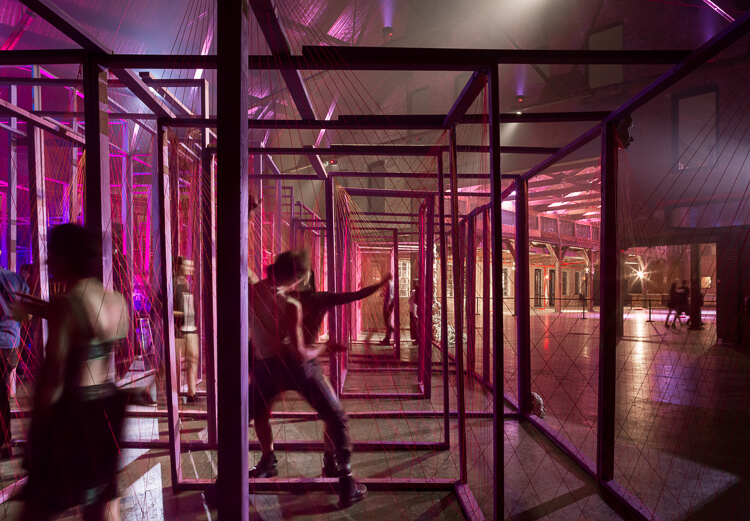

The baseline of low-level surreality sometimes spiked. At the start of veteran beat innovator Prefuse 73’s headlining set, a twentysomething man–fit, overly comfortable, on extremely strong drugs of some sort–pressed himself up against the mesh outside the speaker stack. He’d been dancing laterally but then moved forward, convinced he might pass intangibly through the wires. He thrust at the speakers, eyes closed, like it was possible to fuck the sound. He clawed at the equipment maybe wanting to crawl inside of it, and tried to pull it down towards himself caring only that he’d then be closer to it. He ignored increasingly insistent shoves away from the sound guy. He was a problem.
When security tried to nudge him out, he pretended they didn’t exist. It turned physical. They took him down to the concrete where the space’s inherent awkwardness became obvious. He wasn’t fighting back against the guards, so much as fighting off the idea that his night was over. Realizing quickly that dragging a true believer through the convoluted exit strategies of an art labyrinth was a flawed plan, those guards backed out to regroup. The dude popped up, now bleeding profusely from the head (which he didn’t acknowledge at all), to return to the speakers, his one true love and purpose for being (his human face a distant second, at best). Finally, a guy who’d been dancing, shirtless, in a geographically opposed corridor found his way over and horse-whispered him out of there. Normal security protocol is disrupted by a big ass maze, too.
“That was wild,” said Hillmer. “It’s not without risk. There’s always a little bit of… ‘Dude, I hope this will be cool.’” But unlike an average show, where unexpected drama could make you feel rapidly unsafe, the maze afforded a sort of illusory shark cage comfort. You could hole up in a jutting dead end, immersed in a crowd yet still entirely separated from it physically.
Saturday night’s DJ-oriented bill fostered connection and proximity in spite of that. Where Friday’s audience fanned out, never breaching the literal and figurative fourth wall around the performers’ central cell, Saturday’s club kids crowded in. They filled the maze’s middle box to capacity, buzzing there. Coming from outside, they pulled cords aside to cut straight through walls to join in. I asked Hillmer if maze-cheaters hurt his feelings. “No, because it’s meant to interrupt your experience in some way, in a playful way,” he said. “Even if the barrier is traversed, it’s still there.”
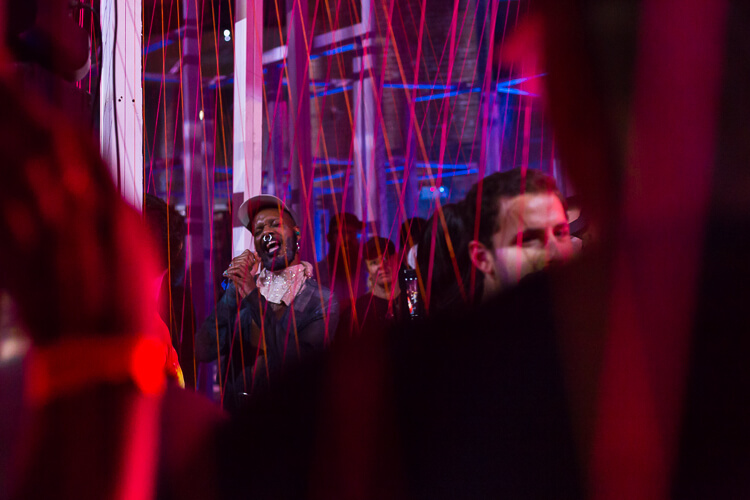

That night’s best performance came from recent Tri Angle records signee Josiah Wise, aka serpentwithfeet. On his recent single, “Flickering”, Wise’s voice is tempered with the creeping dread of The Haxan Cloak’s production. In the flesh, his set was delicate and gentle, mixing modern R & B with soft bossa nova pop. He fostered real intimacy in a space designed for separation, coaxing the crowd into call and response on a song they were probably hearing for the first time, lacing his school teacher’s patience with bits of withering shade. Immediately, he’s a New York artist to watch.
With sun streaming in through Knockdown’s huge windows on Sunday afternoon, the vibe morphed again. The maze itself was so purple then, weirdly warm in the midst of cold concrete. It took way longer than it should have to realize that Brooklyn rapper Thomas Piper’s deep soul voice sat in midst of harsh, synthetic beats that boomed out to the walls. The environment tricked you or at least heavily suggested how you should hear something and how you might feel about it. It made you wonder if maybe that’s always the case.
Photos by Devon Banks.
You might also like 














